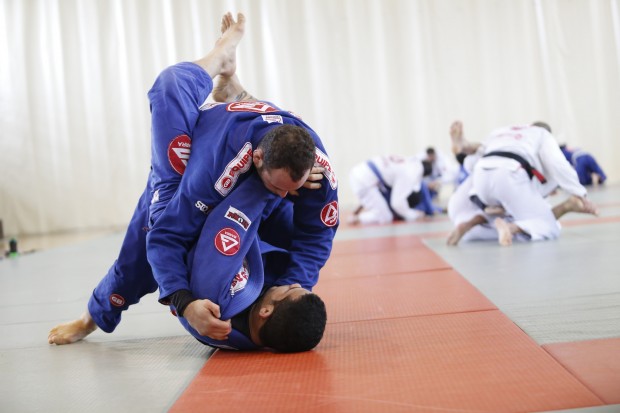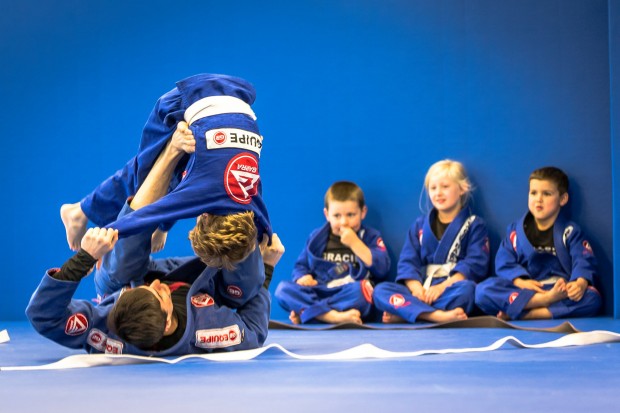The Guard – 6 Building Blocks for Your Guard
Often when discussions of different grappling styles come up – sambo, judo, catch wrestling etc – we are reminded that many key techniques in bjj are also contained in these other styles. But what separates bjj from these other styles is the sophistication and greater emphasis on the guard position.
No other grappling art has developed so many strategies and variations of the guard position. But having a great guard is not as simple as few sweeps and a triangle and there you go!
Let’s take a closer look at these 6 building blocks for a complete guard.
1) How to arrive in guard?
The first step when we examine any position:
How are we arriving in the guard position?
Do you jump to guard from standing?
Do you drill this before competitions?
Are you most often arriving in guard by re-guarding when trapped in side control?
Are you moving from turtle position to go back to guard?
Many of these transitions must be drilled to be smooth when the time comes that you need them!
2) Guard retention
The battle in the guard is often your opponent is trying to pass your guard and you are trying to retain your guard. This is a skill in itself!
Your opponent may gain a strong grip, get an angle and try to pass to the outside – and you need to develop the hip movement and ability to keep the opponent at bay. If your opponent has mostly passed your guard but not yet fully secured side control, you must have the skills to replace the guard and get your legs back in between you and your opponent.
Observing high level bjj competition, we see a guard that is 90% passed and the guard player finds a way to insert a hook and instantly spin back to full guard.
* When you have confidence that you can retain your guard, it allows you to take some chances and be more open with your attacks in the guard.
3) Closed guard – breaking posture
The game in the closed guard is your opponent is trying to maintain their posture and open your legs to pass. Your job on the bottom is to break the opponent’s posture and place them in danger of submission or sweep.
If you lay back in your closed guard and wait and watch what your opponent is going to do… I’ll tell you: they are going to pass your guard!
Research posture and grip breaks to prevent your opponent from even getting started in their pass. A great closed guard is not passive! You must constantly be breaking grips and breaking the balance of the top opponent, not allowing them to feel comfortable.
4) Open guard…hooks!
There are numerous variations of the open guard:
- Butterfly
- De la Riva
- Reverse De la Riva
- X-guard
- Lasso guard
- Spider guard
- Sitting guard
- Lapel guards
- Z-guard / 93 guard
- Rubber guard
- Cross guard
Each of them has its own set of specific grips and hooks that you must master. The grips and hooks are what is going to control your top opponent and prevent them from merely passing your legs. If you have ever had a great guard player wrap you up and dominate you with their hooks you know how tough this is to deal with!
The secret is to learn how to maximize the effectiveness of those grips and hooks to control whichever guard you like to employ.
read also: Bluebelt – Advice on Developing your Guard
5) Sweeps
In competition bjj, sweeps probably account for the majority of points scored. Some guards (ex. Spider guard, De la Riva guard) have an incredible number of different sweeps from the basic position depending on the opponent’s actions.
When you think about it, in brazilian jiu-jitsu, sweeps allow the person on bottom (who could be said to be losing) to reverse the course of the fight in an instant!
Experiment with all of the sweeps from your favourite guards. How do you combine your sweeps with submissions? Can you sweep in the opposite direction when your opponent counters your first sweep attempt?
Ask a high level black belt what are their favorite guard sweeps and they can talk all night… This is the art of the open guard.
6) Submissions
When bjj first appeared in the UFC, bjj showed the other martial arts that it was possible to WIN a fight from the bottom position. This is especially important if there is a large size / weight mismatch between the combatants. Royce Gracie defeating Dan Severn 80lbs. heavier with abtriangle from the bottom was a revolution in the way we thought about fighting.
Triangles, Kimuras, straight armbars, guillotines, leglocks all can be attacked with or without the kimono and should make up the majority of your submission focus from the bottom. Those who like to play the collar in the kimono have numerous variations of the collar choke in addition to the above techniques.
* Playing the collar also helps your no-gi jiu-jitsu in that it teaches you to try to control the head and posture of your opponent.
I have had success with the collar / sleeve grip which allows me to threaten a choke, armbar / triangle and sweep all at once.
** If you are able to threaten your opponent with a submission from the bottom, they may not take as many chances to pass your guard.
read also: Drilling. How To Do It Right
What are your favourite guard techniques?
Gracie Barra Black belt based in Asia
Twitter: @MarkMullenBJJ


